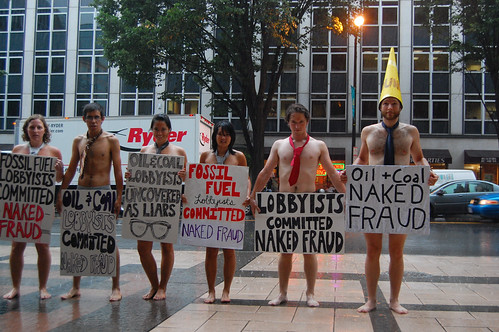A DC Lobbying firm stole the trademarked logo and organizational name of the NAACP and a community group in Charlottesville, VA and wrote a letter purporting to oppose the ACES bill in the house.
This is a prime example of dirty money fueling lies in DC. It is an affront to Democracy and a hindrance to passing the climate legislation our country desperately needs. We need to call them out and make this a national story.
Story from the Charlottesville Daily Progress.
As U.S. Rep. Tom Perriello was considering how to vote on an important piece of climate change legislation in June, the freshman congressman’s office received at least six letters from two Charlottesville-based minority organizations voicing opposition to the measure.
The letters, as it turns out, were forgeries.
“They stole our name. They stole our logo. They created a position title and made up the name of someone to fill it. They forged a letter and sent it to our congressman without our authorization,” said Tim Freilich, who sits on the executive committee of Creciendo Juntos, a nonprofit network that tackles issues related to Charlottesville’s Hispanic community. “It’s this type of activity that undermines Americans’ faith in democracy.”
The faked letter from Creciendo Juntos was signed by “Marisse K. Acevado, Asst Member Coordinator,” an identity and position at Creciendo Juntos that do not exist.
The person who sent the letter has not been identified, but he or she was employed by a Washington lobbying firm called Bonner & Associates.
Gwynn Geiger Hegyi, a partner with the company, traveled to Charlottesville to apologize to Creciendo Juntos’ chairwoman Dilcia Colindres and sent a letter to Freilich.
“As I shared with Dilcia when I travelled to Charlottesville last month to personally apologize for the mistake which we discovered and contacted you about, we immediately fired the person on our staff responsible for the error,” Hegyi wrote in the July 22 letter to Freilich.
Hegyi and others at Bonner & Associates did not return two phone calls Thursday seeking comment for this story.
More than a ‘mistake’
In a letter notifying Perriello’s office about the matter, Freilich said he was “offended” by Hegyi’s characterization of the forged letter as a “mistake.”
“This was not a ‘mistake,’” wrote Freilich, who is also legal director of the Immigrant Advocacy Program of the Legal Aid Justice Center. “This was a deliberately and carefully forged letter that used the logo, address and name of Creciendo Juntos without authorization. Additionally, I understand from Ms. Hegyi that our organization was not the only Charlottesville-area organization whose reputations were used in an unauthorized manner to try to influence Congressman Perriello on this particular vote.”
After being notified of the bogus Creciendo Juntos letter, staffers in Perriello’s office realized that the wording of the letter sounded familiar.
The staffers dug through the stacks of thousands of letters, e-mails and faxes Perriello received about the bill — the American Clean Energy and Security Act of 2009 — and found five more forged letters, these purportedly from the Albemarle-Charlottesville branch of the NAACP.
M. Rick Turner, president of the local NAACP branch, said he checked his organization’s roster and found none of the five people who signed their name to the five faked letters.
NAACP ‘very appalled’
“I am very appalled as the president that our organization has been misrepresented in this way by this bogus … letter,” Turner said. “I hope that whoever’s behind this will be brought to justice.”
In fact, Turner said, the NAACP supports the American Clean Energy and Security Act, as he said it would create good-paying jobs for blacks and reduce harmful emissions, particularly in urban areas.
“Clean energy creates jobs in the urban setting,” he said.
The fake NAACP letters were faxed to Perriello’s office from the Arlington headquarters of a company called Professional Risk Management Services Inc. A representative of the company said she had no knowledge of why the fax would have been sent from her office, adding that at least 60 employees have access to the fax machine.
Perriello’s press secretary, Jessica Barba, said the congressman’s office knows of only the five forged letters, but there may be others they have not yet discovered.
“There could be more, but these are the only ones that we’re aware of right now,” she said.
With regards to the Creciendo Juntos letter, it is not known who — if anyone — hired Bonner & Associates to lobby against the bill, which also is known as cap-and-trade legislation. The staffer who the company said was fired may not have been working in any official capacity when he or she created and mailed the forgery.
Bonner & Associates was founded in 1984 by Jack Bonner and is considered a pioneer in the field of “strategic grassroots,” in which the firm manages grassroots campaigns on behalf of its clients, which have included Fortune 500 companies and national associations in all 50 states.
Artificial campaign
The AARP Bulletin reported in 2006 that the “60 Plus Association” hired Bonner & Associates in 2003 to manage what it called an “Astroturf” campaign against prescription drug legislation in Minnesota and New Mexico, meaning that it was an artificial version of a grassroots campaign.
Bonner & Associates hired callers to identify themselves as members of the 60 Plus Association and urge residents to ask their governors to veto the legislation. Pharmaceutical company Pfizer later admitted that it had paid Bonner & Associates to undertake the campaign, AARP reported.
An examination of lobbyist disclosure forms filed with the Office of the Clerk of the U.S. House of Representatives shows that Bonner & Associates did not register to lobby on behalf of any company or organization against the cap-and-trade bill.
However, a lobbying firm only needs to disclose their clients if the client pays them more than $3,000 in a filing period, at least one employee spends 20 percent of their time lobbying, and that employee made at least two lobbying contacts within the filing period. Managing a grassroots campaign might not require public disclosure of lobbying activities or clients.
Bonner & Associates has disclosed a few clients in recent years. For example, the company took in $150,000 to lobby on behalf of the Electric Utility Shareholders Alliance between 1998 and 2000,
according to the nonprofit Center for Responsive Politics.
In a report Wednesday, the Center for Responsive Politics revealed that oil and gas companies greatly increased their spending on lobbying between April and June, primarily because of the
cap-and-trade energy bill. During the second quarter of 2009, these companies spent $37.7 million on lobbying congress, representing a 30 percent increase over 2008.
Perriello ultimately voted in favor of the bill, which narrowly passed the House on June 26 in a 219 to 212 vote. The bill is now before the U.S. Senate.
Perriello’s vote has drawn the ire of some critics who say the measure will increase electricity bill costs and eliminate jobs.
Barba, however, criticized the bill’s opponents for the forged letters.
“It’s very unfortunate that opponents of this bill would resort to deception and made-up letters,” she said. “Spreading false information is not healthy for real debate in our democracy. Congressman Perriello voted in favor of the bill because of its potential to create clean energy jobs, which is why the NAACP and many other groups supported the legislation in the first place.”





























